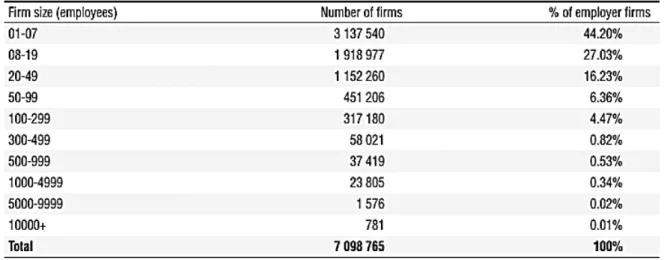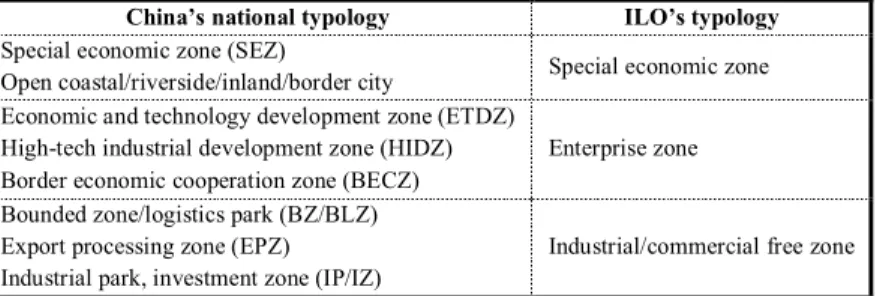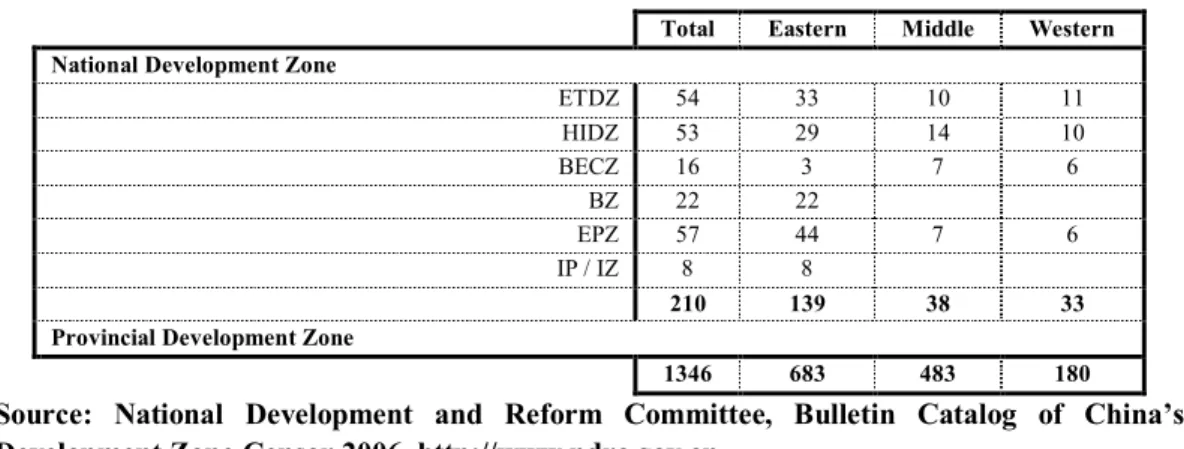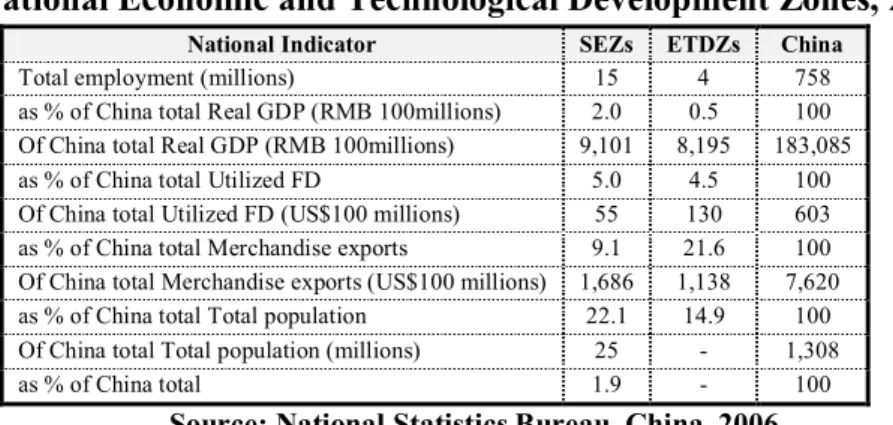Chinese's Export Processing Zones Strategy
Lessons, pitfalls for "Algerian Insight"Dr. DJOUADI Noureddine
University of Echahid Hamma Lakhdar/ALGERIA djouadidz@gmail.com
Received:26 Jan 2016 Accepted: 17 May 2016 Published: 30 June 2016
Abstract:
This paper will try to summarize the Chinese experiences of Industrial Zones, and try : Firstly, to explain the key lessons that Algeria can learn from China's long and successful experience in developing EPZs and SMEs as main elements in the national and local development strategy. Secondly, describe the main success factors of Chinese EPZs to support the SMEs for encouraging and diversify the exports.
For this purpose, this paper is structured in the following way : (01) Introduction (02) The definitions of EPZ and SMEs in Chinese's law, (03) Export Processing Zones (EPZs) in China as vehicles of development (04) Economic Role of China’s EPZs. (05) as a conclusion, the lessons that Algeria can learn from China, and the main pitfalls that Chinese experiences include to avoid.
Keywords: Chinese experiences, Export Processing Zones (EPZs), Economic development, Algeria. (JEL) Classification : O1, O25.
: 1 2 3 4 5 jel O1, O25.
Chinese's Export Processing Zones Strategy
I. Introduction
Since the 1979s, "Industrial Zones" exactly "Export Processing Zones" (EPZ) as type of them and Small and Medium Enterprises (SME) have been tow of the most important mechanisms for export-promotion strategy in China .
This paper will try to summarize the Chinese experiences of Industrial Zones, and try : Firstly, to explain the key lessons that Algeria can learn from China's long and successful experience in developing EPZs and SMEs as main elements in the national and local development strategy. Secondly, describe the main success factors of Chinese EPZs to support the SMEs for encouraging and diversify the exports.
For this purpose, this paper is structured in the following way : (01) Introduction (02) The definitions of EPZ and SMEs in Chinese's law, (02) the Chinese experiences, (03) Export Processing Zones (EPZs) in China as vehicles of development (04) Economic Role of China’s EPZs. (05) as a conclusion, the lessons that Algeria can learn from China, and the main pitfalls that Chinese experiences include to avoid.
II. Small and Medium Enterprises (SMEs) in China :
SMEs definition in China depends on the number of employees, annual revenue, and total assets comprising a company. The definition of an SME in China is quite complex and can include relatively large firms. And according to International Finance Corporation & World Bank Group (2012), there are three different definitions of SMEs in China (See table 1)1.
Table 1: Definition of SMEs in China
Criteria
Chinese Ministry of Industry and Information
Technology (2011) (Meeting 1 of the 3 criteria)
Chinese Economic and Trade Commission (2003) (Meeting 1 of the 3 criteria)
The World Bank Group (Meeting 2 of the 3
criteria)
Small Medium Small Medium
Number of
Employees < 300 300 - 1000 < 300 300 - 2000 < 300 Total Asset NA NA < 40 million RMB 40 - 400 million
RMB < 100 million RMB Total Annual Sales Revenue < 20 million RMB 20 - 400 million RMB < 30 million RMB 30 - 300 million RMB < 100 million RMB
Source: International Finance Corporation & World Bank Group (2012).
According to China Economic Census in 2008, total number firms amounted to nearly 7.1 million. The detailed distribution (illustrated in Table 2) shows that micro and small firms are fundamental for the economic development of China. 44.20% of total Chinese firms are typical micro firms (with less than 7 employees), and at least 87.45% are typical small firms (with less than 7 employees). Based on the Chinese SME definition, the percentage of micro and small firms totals more than 97%.2
table 2 : Distribution of firms in China, 2008 (By firm size)
Source : China Economic Census yearbook 2008, edited by the national Bureau of Statistics (nBS), Beijing: China Statistics press, 2010.
After 2008, the number of company registrations is growing steadily : 3
Companies with registered capital of 0.101.0 million RMB: Annual growth rates were -1.93%, 20.86%, 15.84% and 10.47% in the 2008-2011 period.
Companies with a registered capital of 1.0-5.0 million RMB: Annual growth rates were 3.76%, 26.79%, 23.62% and 15.42% in the 2008-2011 period.
During the first half of 2014 alone, 1.58 million SMEs registered in China. According to statistical data for many years ago, SMEs account more than 99% of Chinese enterprises, about 60% of GDP growth in 2013, 80%of newly increased production value, and make up 99.5% of all businesses nationwide, 60% of sales, 50% of revenue, 70% of export value, and about 75% of jobs across China.
Table 3: The importance of SMEs for trade and economic activity4
Note: SME share of firms, employment and GDP. Fraction of SMEs engaged in export activities. (M) and (S) denote data for manufacturing and services data only.
Chinese's Export Processing Zones Strategy
Data from the National Bureau of Statistics on the number of industrial enterprises above a certain operational scale show that the number of SMEs (industrial enterprises) was 334.321 in 2012, representing 97.3% of total industrial enterprises above a certain operational scale (Figure 1 and Table 4) 5.
Figure 1 : Number of SMEs (industrial enterprises) in China 2007 - 2012
Source: National Bureau of Statistics.
The majority of SMEs are in the services sector (including 24% on health education and social services; 20% governments, parties, social organizations and communities; 4% construction and real estate; 1% technical, scientific and professional); wholesale, retail and catering comprise 19% and manufacturing and processing also 19%6.
Table 4 : SME Landscape (industrial enterprises) 2007 - 2012
Source: National Bureau of Statistics.
Chinese banks have increased lending to the SME sector, given the 15.5% annual growth of SME loans outstanding in 2012. In particular, SME loans outstanding stood at CNY25.15 trillion in 2012, representing 62.2% of total enterprise loans outstanding and 39.9% of total loans outstanding including consumer lending. SMEs in China contributed to 64.7% of total employment of industrial enterprises above a certain operational scale in 2011 and provided 41.5% of total export value of industrial enterprises above a certain operational scale in 2012 (Figure 2) 7.
Figure 2 : SME Exports
Source: National Bureau of Statistics.
III. Export Processing Zones (EPZs) in China : “vehicles of globalization”
Export processing zones (EPZ) are special regulatory areas within countries established to promote export-led growth. The International Labour Organization (ILO) has defined EPZs as “industrial zones with special incentives set up to attract foreign investors, in which imported materials undergo some degree of processing before being exported again.” Unless otherwise stated, this is the definition referenced in this report. EPZs have been called the “vehicles of globalization”. 8
Table 5 : Types of Zones Type of Zone Development Objective Size (Hectares) Typical Location Eligible
Activities Markets Examples
Free Trade
Zone
Support trade Size < 50 Ha Ports of entry Entrepôt and trade-related activities Domestic, re-export Colon Free Zone, Panama Traditional EPZ Export
manufacturing Size < 100 Ha None Manufacturing, other processing Mostly Export Karachi EPZ, Pakistan Hybrid EPZ Export manufacturing Size < 100 Ha None Manufacturing, other processing Export and Domestic market Lat Krabang Industrial Estate Thailand Freeport Integrated development Size < 100 Km² None Multi-use Domestic, internal and export markets Aqaba Special Economic Zone, Jordan Enterprise Zone Urban
revitalization Size < 50 Ha Distressed urban or rural areas
Multi-use Domestic Empowerment Zone, Chicago Single Factory EPZ Export manufacturing Designation for individual enterprises Country wide Manufacturing, other processing Export market Mauritius Mexico Madagascar
Source : World Bank Group, Special economic zones: Performance, lessons, Learned, and implications zone development, Washington, April 2008, P10.
Chinese's Export Processing Zones Strategy
Generally, the EPZs include: 9
a) exemption from some or all export taxes;
b) exemption from some or all duties on imports of raw materials or intermediate goods; c) exemption from direct taxes such as profits taxes, municipal and property taxes; d) exemption from indirect taxes such as VAT on domestic purchases;
e) exemption from national foreign exchange controls; f) free profit repatriation for foreign companies;
g) provision of streamlined administrative services especially to facilitate import and export; h) free provision of enhanced physical infrastructure for production, transport and logistics
In 2008, The World Bank estimates that there are 3000 zones in 135 countries, accounting for over 68 million direct jobs and over 500 billion Dollar of direct trade-related value added within zones10.
In China, since the 1980s, EPZs have played a central role in the growth and liberalization of China’s economy. Between 2002 and 2006, China alone accounts for 40 million employees, but outside China, EPZ employment doubled from 13 to 26 million11.
A few typological distinctions separate different forms of EPZs in China into special economic zones (SEZ), industrial free zones (IFZ), and enterprise zones (EZ). A narrower conception of a Chinese EPZ refers to only 60 such zones with preferential tax and tariff treatments. For this purpose, however, we will use the broader definition and treat them essentially the same, unless otherwise stated. For a detailed description of the different zones.
12
Table 6 : Typology of EPZs in China
China’s national typology ILO’s typology
Special economic zone (SEZ)
Open coastal/riverside/inland/border city Special economic zone Economic and technology development zone (ETDZ)
High-tech industrial development zone (HIDZ) Border economic cooperation zone (BECZ)
Enterprise zone Bounded zone/logistics park (BZ/BLZ)
Export processing zone (EPZ) Industrial park, investment zone (IP/IZ)
Industrial/commercial free zone
Source: ILO, types of zone: An evolutionary typology.
available at: www.ilo.org/public/english/dialogue/sector/themes/epz/typology.htm
Historical, China’s EPZs, or development zones, experienced three waves of development: 13
1. From 1984 to 1990 : Apart from the 9 ETDZs that were set up in 1984, only 9 other Development Zones were set up in the following 6 years.
2. From 1991 to 1999 : was the second stage of booming and slow-down. During its peak in1992, 58 Development Zones were established and 52 HIDZs also appeared at the end of
the year. The amount of Development Zones sextupled from 1990 to 1993, which also helped FDI inflows to China double and triple within those years.
3. After 2000, when China was approaching entry into WTO, series of EPZs (according to China’s typology) were set up to enhance exports. The main aim of the third wave of ETDZs was to implement the “Western China Development” strategy.
So, China authorized its first real batch of 15 EPZs in April 2000, and the first export from these zones occurred in February 2001. The first three EPZs to export were in Chengdu, Hangzhou, and Suzhou. EPZs were scattered throughout China, with some provinces receiving several while others had none14.
By the end of 2005, there were 210 national Development Zones (including 123 Enterprise Zones and 87 Industrial/Commercial Free Zones) and 1346 provincial Development Zones. Among them, about two-third of China’s national Development Zones and half of the provincial ones were located in eastern China, which is its coastal site. Except for the BECZs that are especially set up for the inland regions, other types of development zones are all concentrated in coastal China, particularly the Industrial/Commercial Free Zones. It is only because of the “Western China Development” strategy, that western parts of the country have 10 HIDZs and 6 BECZs at all. 15
Figure 3: The locations of EPZs in China 2001-2005
Source : Xiaoyang Li and Antung Liu, Imitating to Export, August 4, 2014, P 07. Available at: www.hhs.se/contentassets/249bdc81268543db9e223585f4d53e5a/imitating-to-export.pdf
Chinese's Export Processing Zones Strategy
Table 7 : Regional Distribution of China’s Development Zones 2005 Total Eastern Middle Western National Development Zone
ETDZ 54 33 10 11 HIDZ 53 29 14 10 BECZ 16 3 7 6 BZ 22 22 EPZ 57 44 7 6 IP / IZ 8 8 210 139 38 33
Provincial Development Zone
1346 683 483 180
Source: National Development and Reform Committee, Bulletin Catalog of China’s Development Zone Censor 2006, http://www.ndrc.gov.cn.
IV. Economic Role of China’s EPZs :
China, like other countries created EPZs in order to achieve several objectives. Major reason among them is expedites export activities and stimulates rapid economic growth. The other reasons are : Stimulate rapid economic growth, Enhance industrialization, Adopted with Open door policy, Globalization, Attract foreign investment, Provide special areas where potential investor would get congenial investment climate, Smooth export procedure, free from cumbersome procedures, Development export promotion strategy, More employment generation, Development of export oriented industries, Proper use of domestic available raw materials16
In other words, we can say that the main objectives of EPZs are : 17
Promotion of Export,
Promotion of Diversification of Export,
Generation of employment,
Development of Backward and Forward Linkage,
Transfer of Technology,
Upgrade of Skill,
Development of Management,
Promotion of International Marketing.
Although the combined area of all 49 ETDZs is only 584 square kilometers which is 0.006% of China, they contributed 3.8% of China’s GDP, 8% of China’s Gross Industrial Output (GIO) and 7% of Industrial Value Added (IVA) in 2005. Before 2000, the ETDZs had a stable share of China’s FDI inflow, which is about 8%. After that, it doubled within 5 years to 16.7% in 2005. Together with that, the share of ETDZs’ exports also doubled from 6.85% in 1995 to 12.49% in 200518.
In 2006, the five initial SEZs accounted for 5% of China’s total real GDP , 22% of total merchandise exports, and 9% of total FDI inflows. At the same time, the 54 national ETDZs accounted for 5% of total GDP, 15% of exports, and 22% of total FDI inflows.
Figure 4 : Share of National ETDZs in China’s Economy(%)
Source: Ministry of Commerce (China), Development Report of National Economic and Technology Development Zones 2005, http://www.fdi.gov.cn.
Table 8: Performance of Initial Five Special Economic Zones (SEZ) and National Economic and Technological Development Zones, 2006
National Indicator SEZs ETDZs China
Total employment (millions) 15 4 758 as % of China total Real GDP (RMB 100millions) 2.0 0.5 100 Of China total Real GDP (RMB 100millions) 9,101 8,195 183,085 as % of China total Utilized FD 5.0 4.5 100 Of China total Utilized FD (US$100 millions) 55 130 603 as % of China total Merchandise exports 9.1 21.6 100 Of China total Merchandise exports (US$100 millions) 1,686 1,138 7,620 as % of China total Total population 22.1 14.9 100 Of China total Total population (millions) 25 - 1,308
as % of China total 1.9 - 100
Source: National Statistics Bureau, China, 2006.
HIDZs is one of the important policy measure that has been introduced to enhance technology advancement and innovation. Over the 15 years since the foundation of HIDZs, they have shared half of China’s high-tech product GIO and one third of China’s high-tech product export, which is 218.2 billion US dollars in 2005. In addition, the ETDZs also share another one third of China’s high-tech product GIO and export, which means the national development zones are in fact the engines of China’s high-tech industries and greatly contribute to its technology upgrading19.
The main advantage of HIDZs is their intensity of R&D; their expenditure on R&D in 2002 is 31.4 billion RMB Yuan and shares 24.4% of China total expenditure on R&D. Within the following four years, their R&D expenditure tripled to 105.4 billion RMB Yuan and the share rose to 35.1 in 2006. This makes the HIDZs very important innovation entities around China, especially for the industrial R&D. In spite of the fact that ETDZs had only a share of 6.2% of China’s R&D expenditure in 2005, they shared another one third of China’s high-tech products export, which raised from 31.3% in 2004 to 35.5% in 200520.
Chinese's Export Processing Zones Strategy
Figure 5 : Share of HIDZs in China’s Hi-tech Export and R&D (%)
Source: Ministry of Science and Technology, China High-tech Industries Statistics (various years), http://www.sts.org.cn.
Generally, Firms inside EPZs tend to pay higher wages than firms outside the zones.
In 1997, the average wage at a Chinese enterprise was only 62% of that of FFEs, and manufacturing wages was just 58% of FFE wages. However, the FFEs comparative advantage for wages has reduced since then. The average wage at China’s enterprises reached 90% of that of FFEs in 2005 and so the wages within Development Zones are certainly not higher in comparison any more.
Figure 6 : Comparative Wage of Foreign Funded Enterprise (FFE = 1)
Source: National Statistics Bureau, China Statistics Yearbook (various years), Beijing: China Statistics Press, 2006.
Employment in EPZs has increased substantially in developing countries: in 2002, it stood at an estimated 30 million in China and 13 million (up from 4.5 million in 1997) in other countries. By 2006, figures had increased to 40 million in China and 26 million elsewhere21.
Table 9 : Evolution of EPZs and Employment 1970 - 2006
Source: X. Cirera and R. Lakshman, The impact of export processing zones on employment, wages and labour
conditions in developing countries, International Initiative for Impact Evaluation, March 2014, P07.
The fellow Table shows the rise in employment generated in EPZs, as estimated by the ILO, giving a more detailed picture of employment by region. An extremely large proportion (63 per cent) of this employment is concentrated in China, although some of the zones in China are not necessarily for exporting. This share is, however, decreasing from 70 to 60 per cent. Only 0.05 per cent of employment in EPZs is in Europe. Clearly the importance of EPZs for employment is primarily in developing countries, especially Asia. This is likely to be explained by the number and size of EPZs in these countries, and also by the more labour-intensive sector composition of EPZs in these countries.
Table 10 : Distribution of employment and EPZs by region
Source: X. Cirera and R. Lakshman, The impact of export processing zones on employment,
wages and labour conditions in developing countries, International Initiative for Impact
Chinese's Export Processing Zones Strategy
V. CONCLUSION : Costs and benefits of EPZs
China offers very useful experiences for Algeria in order to create Industrial Zones or creating "Export Processing Zones" (EPZ) to support the SME for encouraging and diversify the exports.
EPZs confer two main types of benefit, which explain in part their popularity: “direct” economic benefits such as employment generation and foreign exchange earnings; and the more elusive “indirect” economic benefits, which are summarized in fellow table.
Table 11: Potential Benefits Derived from EPZs Direct benefits Indirect benefits
Foreign Exchange earnings
FDI
Employment generation
Government revenue
Export growth
Skills upgrading
Testing field for wider economic reform
Technology transfer
Demonstration effect
Export diversification
Enhancing trade efficiency of domestic firms
Source: World Bank staff
While China had success in the establishment of SEZs, it get many benefits, but not all countries whose used the policies of creating SEZs get benefits, some countries encounter problems and complexities from the establishment of SEZ.
Table 12. Prospective benefits and costs of EPZ policy
Benefits Costs or Loss of Revenue
Export growth
Foreign direct investment
Foreign exchange earnings
Employment
Technology transfers
Information exchange with companies
Government revenue
Infrastructure investment
Administrative costs (setting up of separate administrative arrangements)
Foregone tax revenue (tariffs, income tax and other taxes forgone)
Subsidies
Social and economic costs (potential loss of worker rights and protection afforded under national laws and regulations and possible degradation of the environment)
Source: OECD Secretariat 1999.
Many factors contributed to the success of China’s EPZs, and in every case, the situations and factors might be different. However, their success draws on some common key elements and points to some common lessons : Strong commitment and support of the government to pilot market-oriented economic reforms. Land Reforms. Investment incentives and institutional autonomy. Foreign Direct Investment and the Chinese diaspora. Technology learning, innovation,
upgrading, and strong links with the domestic economy. Innovative cultures. Clear objectives, benchmarks, and competitions. Location advantages. While overall EPZ lessons from China are positive and encouraging, there are also a few adverse lessons which other countries should try to avoid in their pursuit of EPZ programs. Such lessons include: Mushroom approach at local level and high-level overlaps at the later stage. Environmental degradation. Unbalance between industrial development and social dimensions.
On general, Algeria need to learn more from Chinese's experience in establishing EPZs as an instrument for exports diversity, exactly in this period when Oil prices are falling terrible.
Figure 7 : Crude oil price movement, 2014
Chinese's Export Processing Zones Strategy
References :
1
. Djouadi Noureddine and others, Evolution of Sustainable Development Strategies in Chinese SMEs, International Journal of Science, Environment, and Technology, Vol. 3, No 2, 2014, www.ijset.net, P 699 – 700.
2
. OECD, Financing SMEs and Entrepreneurs 2015, April 2015, P 140. Available at :
https://g20.org/wp-content/uploads/2015/05/OECD-Financing-SMEs-and-Entrepreneurs-2015-An-OECD-Scoreboard-April-2015.pdf.
3. OECD, Financing SMEs and Entrepreneurs 2015, Op. Cit, P 140.
4 . WTO, International Trade Centre, SME COMPETITIVENESS AND AID FOR TRADE, 2014, P 06. 5
. Asia SME Finance Monitor 2013, Asian Development Bank 2014, Available at: http://adb.org/sites/default/files/pub/2014/asia-sme-finance-monitor-2013.pdf,P 44.
6. OECD, Financing SMEs and Entrepreneurs 2015, April 2015, Available at:
https://g20.org/wp-content/uploads/2015/05/OECD-Financing-SMEs-and-Entrepreneurs-2015-An-OECD-Scoreboard-April-2015.pdf, P 140.
7. Asia SME Finance Monitor 2013, Op.Cit ,P 44. 8
. Jamie K. McCallum, Export processing zones : Comparative data from China, Honduras, Nicaragua and South Africa, Working Paper No.21, International Labour Organization, March 2011, P 01.
9
. Jamie K. McCallum, Export processing zones, Op. Cit, P 01.
10. World Bank Group, Special economic zones: Performance, implications and lessons learned for zone development, Washington, 2008. 11
. International Labour Organization, Economic development and working conditions in export processing zones: A survey of trends, Working Paper No. 3, 2008.
12
. Jamie K. McCallum, Export processing zones, Op. Cit, P 06.
13. Xiaolan Fu and Yuning Gao, Export Processing Zones in China: A Survey, Op. Cit, P 6-7. 14. Xiaoyang Li and Antung Liu, Imitating to Export, August 4, 2014, P 06. Available at:
www.hhs.se/contentassets/249bdc81268543db9e223585f4d53e5a/imitating-to-export.pdf
15
. Xiaolan Fu and Yuning Gao, Export Processing Zones in China: A Survey, A report submitted to ILO, 31/10/2007, P 5.
16
. Impact of EPZ on National Economy . Available at:
http://www.assignmentpoint.com/business/organizational-behavior/impact-of-epz-on-national-economy.html
17 . Impact of EPZ on National Economy , Op. Cit.
18. Xiaolan Fu and Yuning Gao, Export Processing Zones in China: A Survey, Op. Cit, P 20. 19
. Xiaolan Fu and Yuning Gao, Export Processing Zones in China: A Survey, Op. Cit, P 27.
20
. Xiaolan Fu and Yuning Gao, Export Processing Zones in China: A Survey, Op. Cit, P 28.
21 . Xavier Cirera and Rajith Lakshman, The impact of export processing zones on employment, wages and labour conditions in developing









